Once again, the Village of Gays Mills will be providing excellent community forestry training for surrounding partners and cooperators. Workshop attendees will learn basic information to manage and care for their trees throughout their lifespan. Use the brochure found here to register. For any questions, please contact Cindy Kohles, Gays Mills Village Forester, at (608) 872-2184.
Month: July 2019
2019 First Downs for Trees
Green Bay Packers and DNR staff plant a ceremonial Sterling Linden tree in Titletown to help offset the Green Bay Packer’s carbon footprint produced by traveling to away games. Trees naturally sequester carbon dioxide, providing a long-term solution to the problem because trees sequester more and more carbon as they grow larger. This marks the 9th year of the Packer’s First Downs for Trees (FDFT) Program which has planted 5,144 trees to date throughout Brown County.
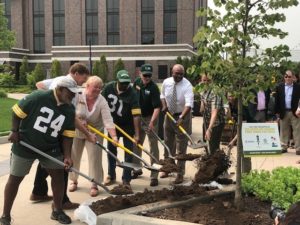
DNR Secretary Cole, DNR staff and former Packers Johnnie Gray and Gerry Ellis planting a tree.
Cambridge Tree Project
How does a community manage to increase its street and park tree species diversity by 445% without spending ANY public funds to purchase trees?!! Look no further than the Village of Cambridge, WI (pop. 1,500) for an answer.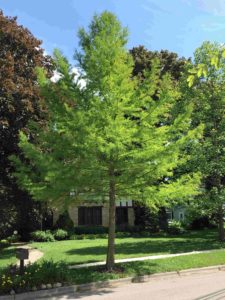 Continue reading “Cambridge Tree Project”
Continue reading “Cambridge Tree Project”
Wisconsin DNR Urban Forestry News subscriber survey
Introduction
Providing timely and relevant information to the Wisconsin urban forestry community is a key role of the Wisconsin DNR Urban Forestry program. One of the ways in which this goal manifests itself is through a monthly newsletter received by 5,555 subscribers (May 2019). In order to ensure that the newsletter content is relevant and timely, the Urban Forestry program surveyed subscribers in spring 2019. Results are shown and interpreted below and suggestions made for future newsletter editions. Continue reading “Wisconsin DNR Urban Forestry News subscriber survey”
Professionally-designed HRD guidelines now available
 The professionally-designed version of the Heterobasidion root disease (HRD) stump treatment guidelines is now posted on the DNR’s HRD webpage. The revised stump treatment guidelines, developed to reduce the risk of introduction and spread of HRD in Wisconsin, were implemented January 1, 2019. The content is the same as the guidelines that were approved last year, but this document has a layout that is much more user-friendly. Explore the new look of the HRD guidelines.
The professionally-designed version of the Heterobasidion root disease (HRD) stump treatment guidelines is now posted on the DNR’s HRD webpage. The revised stump treatment guidelines, developed to reduce the risk of introduction and spread of HRD in Wisconsin, were implemented January 1, 2019. The content is the same as the guidelines that were approved last year, but this document has a layout that is much more user-friendly. Explore the new look of the HRD guidelines.
Watch for signs of oak wilt
Linda Williams, forest health specialist, Woodruff, Linda.Williams@wisconsin.gov, 920-360-0665
Trees in the red oak group (those with points on their leaves) that were infected with the oak wilt fungus this spring will rapidly drop their leaves from July to September and be dead by fall. This wilting and dropping of the green leaves happens quickly. Once it starts, the tree will drop most of its leaves within just a few weeks.
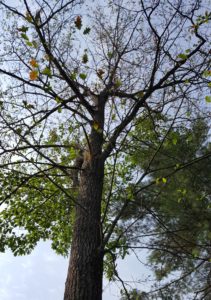
Tree dying from oak wilt with rapidly dropping leaves. The tree was injured in May, attracting the beetles that help spread the fungus, and the tree was dead by the end of the year. Photo was taken in August.
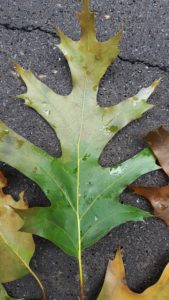
Red oak leaf from infected tree. Leaves are often green at the base, with the outer portions of the leaf appearing water-soaked or brownish.
Ants, aphids and sooty mold on white pine
Linda Williams, forest health specialist, Woodruff, Linda.Williams@wisconsin.gov, 920-360-0665
Ants, aphids, and sooty mold can cause stunting and death of young white pines, but fortunately there are some steps you can take to protect your trees from these pests.
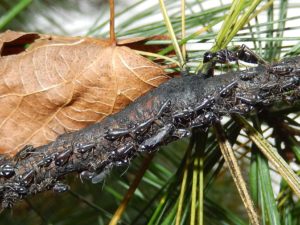
Ants (upper right) guard aphids from predators as they feed. In exchange, the ants collect the sweet honeydew excreted by the aphids.
Continue reading “Ants, aphids and sooty mold on white pine”
Watch for cherry scallop shell moth defoliation
Mike Hillstrom, forest health specialist, Fitchburg, Michael.Hillstrom@wisconsin.gov, 608-513-7690
Cherry scallop shell moth, a native defoliator, is back again in Jefferson and Walworth counties. Several residents recently reported large numbers of moths in areas that have experienced multiple years of defoliation by this insect.
Eggs laid by those moths are expected to hatch soon, and the emerging caterpillars will begin feeding on cherry tree foliage. Hopefully, populations of egg-parasitizing natural enemies will be high enough this year to provide relief to stressed trees.
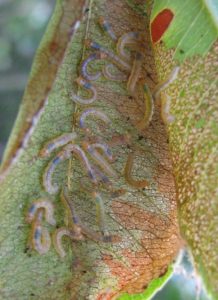
Early instar caterpillars on cherry leaf.
Continue reading “Watch for cherry scallop shell moth defoliation”
Heavy seed crop leads to sparse-looking trees
Todd Lanigan, forest health specialist, Eau Claire, Todd.Lanigan@wisconsin.gov, 715-839-1632
You may have noticed some of the elms and maples had a lot of brown in them at the end of May and early June. Some elms and maples produced a lot of seed this spring, which reduced the amount of energy available for producing leaves. With fewer leaves and more of the brown, papery seeds, the trees can take on a thin, brown appearance.
Heavy seed years can occur for many reasons. It happens naturally from time to time and it can also be stimulated by environmental stressors. A couple of examples of environmental stressors are: excessive moisture, winter injury and frost damage to roots.
The cause of this year’s heavy seed production is anyone’s guess. There does not appear to be a common pattern between the affected trees to indicate whether it was simply a normal heavy seed year or related to an environmental factor.
Browning on tamarack needles
Linda Williams, forest health specialist, Woodruff, Linda.Williams@wisconsin.gov, 920-360-0665
Defoliation from larch casebearer (Coleophora laricella) is showing up in some areas of northeast and northcentral Wisconsin. The defoliation is patchy and of moderate intensity, resulting in trees with various degrees of browning due to the insect’s feeding habits. Some appear pale yellow or brown throughout the crown while others only have partial browning.
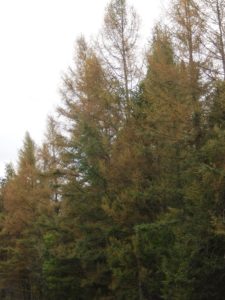
Defoliation by larch casebearer will cause needles to turn yellow then brown. Trees will usually send out more needles and be green again by mid-summer.
